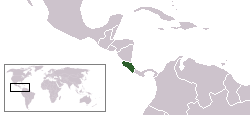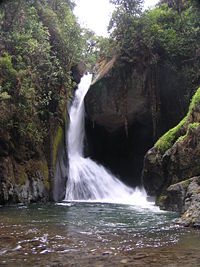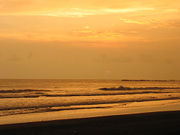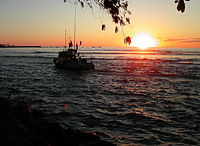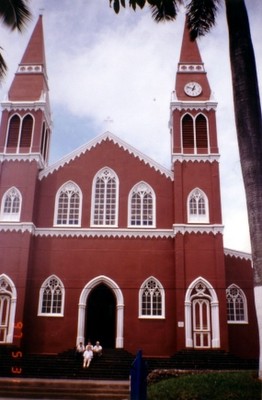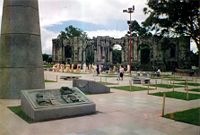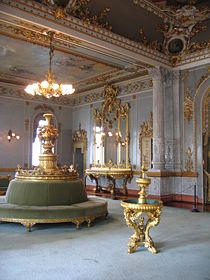Difference between revisions of "Costa Rica" - New World Encyclopedia
(images ok) |
|||
| Line 1: | Line 1: | ||
| − | {{Contracted}}{{Submitted}} | + | {{Images OK}}{{Contracted}}{{Submitted}} |
| + | |||
{| border=1 align=right cellpadding=4 cellspacing=0 width=300 style="margin: 0 0 1em 1em; background: #f9f9f9; border: 1px #aaaaaa solid; border-collapse: collapse; font-size: 95%;" | {| border=1 align=right cellpadding=4 cellspacing=0 width=300 style="margin: 0 0 1em 1em; background: #f9f9f9; border: 1px #aaaaaa solid; border-collapse: collapse; font-size: 95%;" | ||
|+<big><big>'''República de Costa Rica'''</big></big> | |+<big><big>'''República de Costa Rica'''</big></big> | ||
Revision as of 21:22, 23 January 2007
The Republic of Costa Rica ("Rich Coast") is a country in Central America, bordered by Nicaragua to the north, Panama to the south-southeast, the Pacific Ocean to the west and south, and the Caribbean Sea to the east. Costa Rica is seen as an example of political stability in the region, and is sometimes referred to as the "Switzerland of Central America" because of its high growth rates, economic stability, and low crime rates. With a population of 4 million the country enjoys a literacy rate of over 90 percent. It was the first country in the world to constitutionally abolish their nation's army in 1948. Since then it has experienced unbroken democratic rule.
Costa Rica is also at the forefront of conservation and environmental management innovations that recognize biological resources as an important national asset. Costa Rica has developed one of the world's most successful ecotourism industries.
Geography
Costa Rica is located on the Central American isthmus, 10° North of the equator and 84° West of the Prime Meridian. It borders both the Caribbean Sea and the North Pacific Ocean with a total of 1,290 km of coastline, 212km (132 mi.) on the Caribbean coast and 1016 km (631 mi.) on the Pacific.
Costa Rica's border with Nicaragua covers 309 km (192 mi.) and Panama's border is 639 km (397 mi.). In total, Costa Rica comprises 51,100 km² (19,730 sq. mi.), of which 50,610 km²(19,541 sq. mi.) is land and 440 km² (170 sq. mi.) is water, making it slightly smaller than the U.S. state of West Virginia and about half the size of Ireland. Costa Rica is the most geologically diverse area in Central America. From its rolling hills in the central highlands to its rain forests, white sand beaches, hot springs and volcanoes, Costa Rica is full of geological wonders.
The highest point in the country is Cerro Chirripo, with 3,810 m (approximately 12,515 feet), the second highest peak in Central America, after Volcan Tajumulco in Guatemala. The highest volcano in the country is the Irazú Volcano (3,431 m or 11,257 feet).
Costa Rica also is comprised of several islands. Cocos Island stands out because of its distance from continental landmass (24 km², 500 km or 300 miles from the Puntarenas coast), but Calero Island is the largest island with 151.6 km²(59 sq mi.)
The largest lake in Costa Rica is Lake Arenal. The country has a model national park system: a developed and progressive system which stresses ecotourism. Costa Rica protects over 25 percent of its national territory within national parks.
Costa Rica is divided into 8 regions or provinces which are Guanacaste, Alajuela, North Puntarenas, Heredia, Cartago, Limon, San Jose and South Puntarenas.
History of Costa Rica
In Pre-Columbian times the Native Americans in what is now Costa Rica were part of the Intermediate Area located between the Mesoamerican and Andean cultural regions. This has recently been redefined to include the Isthmo-Colombian area, defined by the presence of groups that spoke Chibchan languages. These groups are also believed to have created the Stone Spheresof Costa Rica, between 200 B.C.E. and AD 1600.
Christopher Columbus, who stayed for 17 days in 1502, was so impressed by the gold decorations worn by the friendly locals he gave it the name Costa Rica, 'the rich coast'. The native Mayans and Aztecs were conquered by Spain later in the 16th century. Costa Rica became the southernmost province in the Spanish territory of New Spain. The provincial capital was in Cartago. When gold was not found in Costa Rica the Spanish colonizers lost interest in the region. As a result, Spanish settlers who stayed had to work the land of the highland valleys without the aid of slaves. They did not mix with the local indigenous peoples, who were small in number, nor with the Afro peoples on the east coast who arrived in the era of the African slave trade. As a result the majority ethnic group of Costa Rica is overwhelmingly white European (96 percent). They refer to themselves as Ticos.
After briefly joining the Mexican Empire of Agustín de Iturbide, Costa Rica became a state in the United Provinces of Central America from 1823 to 1839. In 1824, the capital moved to San José. From the 1840s on, Costa Rica was an independent nation. One province, Nicoya is the capital city, was once an autonomous region known as Partido Nicoya. In 1824 its inhabitants voted to peacefully annex their land to Costa Rica. This province, now known as Guanacaste, is the only Costa Rican province which has its own flag and national anthem. It is known for its strong ties to its indigenous heritage.
Costa Rica has mostly avoided the violence that has plagued Central America. Since the late 19th century only two brief periods of violence marred its democratic development. In 1949, President José Figueres Ferrer abolished the army; and since then Costa Rica has been one of the few countries to operate a democratic system without the assistance of a military.
Costa Rica, although still a largely agricultural country, has achieved a relatively high standard of living. Land ownership is widespread and it hosts a rapidly expanding electronics industry.
Politics
Costa Rica is a democratic republic with a strong system of constitutional checks and balances. Executive responsibilities are vested in a president, who is the country's center of power. There are two vice presidents and a 15-member cabinet that includes one of the vice presidents. The president and 57 Legislative Assembly deputies are elected for four-year terms. Costa Rica uses a form of proportional representation to elect its national legislative body. Governors appointed by the president head the country's seven provinces, but they exercise little power. There are no provincial legislatures. Autonomous state agencies enjoy considerable operational independence; they include the telecommunications and electrical power monopoly, the nationalized commercial banks, the state insurance monopoly, and the social security agency. Costa Rica has no military by constitution and maintains only domestic police and security forces for internal security.
A constitutional amendment approved in 1969 limited presidents and deputies to one term, although a deputy may run again for an Assembly seat after sitting out a term. An amendment to the constitution to allow second presidential terms was proposed and the constitutionality of the prohibition against a second presidential term were challenged in the courts. In 2003 the prohibition was officially recognized as anti-constitutional, thus allowing Óscar Arias (Nobel Peace Prize, 1987) to run for President a second time in the 2006 elections. Arias won the 2006 presidential elections by a very thin margin. Arias supports the free trade agreement with the United States.
The success of democracy in Costa Rica has much to do with the grass roots, hands-on involvement of everyday Ticos. They do not take their peaceful nation for granted in a region that has often been rife with instability due to political corruption, dominating military regimes, poverty, and the lure of the international drug trade. Costa Rica shares its' national wealth through good health care and education programs available to all. Almost 30 percent of the national budget is dedicated to education and culture. Costa Rica enjoys an overall life expectancy of 76 years, which is the highest in Latin America according to the CIA World Factbook.
Economy
Costa Rica's economy is dependent on ecotourism, agriculture, textiles and, more recently, exports of electronic circuits. Coffee is the king of exports and some coffee plantations are utilizing a conservationist attitude in farming this crop through self-sustaining growing methods. "Shade coffee" is the name given to coffee grown under the natural forest canopies. Costa Rica's location in the Central American isthmus provides easy access to American markets. It is in the same time zone as the central part of the United States and has direct ocean access to Europe and Asia. The United States is the greatest recipient of Costa Rican exports.
The economy has been booming for Costa Rica because the government implemented a seven year plan of expansion in the high tech industry. There are tax exemptions for those who are willing to invest in the country. Costa Rica is an attractive destination for international investment as it is very progressive in modernizing and expanding it's economy.
Several global high tech corporations like chip manufacturer Intel, pharmaceutical company Glaxo Smith Kline and consumer products company Procter & Gamble have started developing exporting operations. Trade with Southeast Asia and Russia has boomed during 2004 and 2005, and the country is expected to obtain full Asia-Pacific Economic Cooperation Forum (APEC) membership by 2007 (the country became an observer in 2004).
Costa Rica is a member of CABEI, the Central American Bank for Economic Integration, which manages purposeful strategies for the reduction of poverty, improvement of telecommunications and transportation infrastructure, and encouragement of entrepreneurial development and free enterprise throughout Central America.
In early 2004 Costa Rica became the fifth member of the Central American Free Trade Agreement (CAFTA). As of 2006, the country was still addressing many sensitive issues with the implementation of the Agreement. A debate on whether to accept or decline the policies that entail economic engagement as a CAFTA member is still underway.
The unit of currency is the Costa Rican colón (CRC).
Flora and Fauna
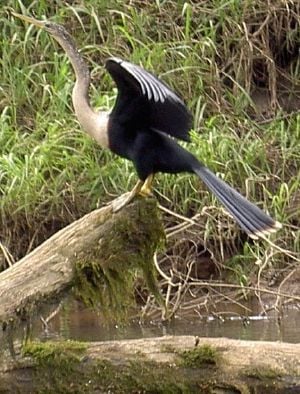
Costa Rica is a true tropical paradise. It is home to a rich variety of plants and animals. While the country has only about 0.1 percent of the world's land mass, it contains 5 percent of the world's biodiversity. Unique and exotic fruits and vegetables contribute to a delicious array of Tico cuisine.
Possessing incredible natural beauty and tropical and semitropical climates, Costa Rica is a showcase of wildlife, rain forests and sea life. Costa Rican's have taken a conservational stance towards the beautiful and bountiful land. More than 25 percent of Costa Rica is composed of protected forests and reserves. There are 32 national parks, 8 biological reserves, 13 forest reserves and 51 wildlife refuges. Each of these natural refuges are unique. The Cocos Island Marine Conservation Area is about 500 km (310 miles) out into the Pacific Ocean and is only open to tours with special permission. Corcovado National Park is internationally renowned among ecologists for its biodiversity (including big cats and tapirs). Tortuguero National Park is home to the spider monkey, howler monkey, White-throated Capuchin monkeys, the Three-toed sloth, 320 species of birds (including eight species of parrots), and a variety of reptiles. The Monteverde Cloud Forest Reserve hosts 2,000 plant species including numerous orchids. Over 800 types of bird can be found here, as well as over 100 species of mammals.
Demographics
In the central part of the country, most people are of European descent but some are also Mestizos (mixed European and Native American ancestry). As a result of very little intermarriage, most of the population today retains European complexions. The pure indigenous population today numbers about 29,000, less than one percent of the population. In Guanacaste, most of the population descends from a mix of the Chorotega Indians, Bantu Africans and Spaniards. Descendants of black 19th-century Jamaican immigrant workers constitute an English-speaking minority and at three percent of the population number about 96,000. Costa Ricans of mestizo and European descent account for a combined 94 percent (the vast majority being of Spanish decent). Another one percent is ethnically Chinese. [1]In addition there are many Americans who either come to retire or work and live in the country.
Today there is a growing number of Amerindians who migrate for seasonal work opportunities as agricultural workers mainly in the south-eastern border region with Panama. The most important group of immigrants in Costa Rica are Nicaraguans, who represent ten percent of the population. Most of them were originally refugees from civil war during the late 1970s and 1980s, but after the Esquipulas Peace Agreement an increasing number of Nicaraguans continue to migrate into Costa Rica due to economic reasons. There is also a growing number of Colombian, Panamanian and Peruvian immigrants. The Costa Rican attitude towards these immigrants is that by taking good care of them they are investing in the future of the country.
Religion
Christianity is the main religion in Costa Rica. Some 92 percent of Costa Ricans are Christian. Like many other parts of Latin America, Protestant denominations are enjoying rapid growth. However 3 in 4 Costa Ricans still adhere to Roman Catholicism. Due to small but recent immigration from Asia, the Middle East, and other places, new religions have sprung up. The most popular being Buddhism (due to a growing Chinese community of 40,000), with even smaller numbers of Jewish, Muslim, and Hindu adherents.
Culture
In Costa Rica, the locals refer to themselves as Tico, maje or mae (sort of "man", actually maje means "dumb") idiom in a very popular and "only with close friends" way, or tica (female). "Tico" comes from the locally popular usage of "tico" diminutive suffixes (eg. 'momentico' instead of 'momentito'). The tico ideal is that of a very friendly, helpful, laid back, unhurried, educated and environmentally aware people, with little worry for deadlines or the "normal" stresses of modern life. Visitors from the United States are often referred to as gringos, which is virtually always congenial in nature. The phrase "Pura Vida" (literally pure life) is a motto ubiquitous in Costa Rica. It encapsulates the pervading ideology of living in a peaceful, calm, unflustered manner, appreciating a life surrounded by nature and family and friends.
Costa Rican traditions and culture tend to be almost identical to Spanish Culture or European culture. Their accent with every-day used words is the most Spanish sounding among Central America, if not in Latin America in general. Costa Rica boasts a varied history. It was the point where the Mesoamerican and South American native cultures met. The northwest of the country, Nicoya, was the southernmost point of Nahuatl cultural influence when the Spanish conquerors came in the 16th century. The center and south portions of the country had Chibcha influences. However the Indian people influenced Costa Rica as a whole very little as many of them died from disease and mistreatment by the Spaniards. The Atlantic coast was populated with African slaves. In addition, during the 19th century thousands of Chinese and Italian families came to the country to work on the construction of the railroad system connecting the urban populations of the Central Plateau to the port of Limon in the Caribbean.
One of the best known cultural celebrations in Costa Rica is known as Guanacaste Days, a 7-day celebration to commemorate the province's peaceful annexation to Costa Rica in 1824. Traditional Guanacastan music, food, handicrafts, evening fireworks and parades all give atmosphere to this yearly celebration of peace and democracy. The people of Guanacaste province have a saying, "De la Patria por Newstra Voluntad" which translates into : "part of the country by our choice".
ReferencesISBN links support NWE through referral fees
- Booth, John A., Costa Rica: Quest for Democracy Westview Press (1998) ISBN 0813376319
- Daling, Tjabel, Costa Rica in Focus: A Guide to the People, Politics and Culture, Interlink Publishing Group (2001) ISBN 1566563976
- Biesanz, Mavis Hiltunen, and Richard Biesanz, Karen Zubris Biesanz, The Ticos: Culture and Social Change in Costa Rica, Lynne Rienner Publishers (1998) ISBN 1555877370
- Greenspan, Eliot, Costa Rica For Dummies, For Dummies (2005) ISBN 0764584413
Special Credits
- World and I online. Articles: "Guanacaste Days: Celebrating Demoncracy's Heritage in Costa Rica". 2001. Tess Gadwa. "At Peace Amid Turmoil: Costa Rica's Unexpected Story of Success". 2004. Ben Barber. "Costa Rican Cuisine". 1991. Kay Shaw Nelson.
- The Washington Times-Honduras. Article. March 24, 2000. "CABEI committed to fight against poverty in Central America".
- Geographica. 2004. Costa Rica.
External links
- Costa Rican History
- ICT official tourism site (English | Spanish | Deutsch | Français)
- The Pros and Cons of EcoTourism in Costa Rica
- Constitution of the Republic of Costa Rica (In Spanish)
- Costa Rica City Guide - Message Board and Photo Gallery (free site).
Credits
New World Encyclopedia writers and editors rewrote and completed the Wikipedia article in accordance with New World Encyclopedia standards. This article abides by terms of the Creative Commons CC-by-sa 3.0 License (CC-by-sa), which may be used and disseminated with proper attribution. Credit is due under the terms of this license that can reference both the New World Encyclopedia contributors and the selfless volunteer contributors of the Wikimedia Foundation. To cite this article click here for a list of acceptable citing formats.The history of earlier contributions by wikipedians is accessible to researchers here:
The history of this article since it was imported to New World Encyclopedia:
Note: Some restrictions may apply to use of individual images which are separately licensed.


